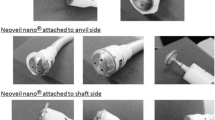Abstract
Background
The high incidence of anastomotic stenosis after gastrointestinal surgery using circular staplers is a major problem. In response, we have developed a new technique that uses a linear stapler to enlarge an anastomotic opening made using a circular stapler.
Methods
Anastomoses were created by the new technique or by the conventional approach using a circular stapler in pig small intestine. The method was also applied in treatment of a colon cancer patient.
Results
The area of the anastomotic opening obtained with the new technique was more than 3 times that in the control (p < 0.001), with no significant difference between the methods in a leak test. Follow-up of the patient undergoing surgery with this approach revealed an uneventful course with a widely patent anastomosis confirmed after 3 months.
Conclusions
This procedure provides a larger anastomotic opening than conventional anastomosis with circular staplers, without impairing the integrity of the anastomosis.



Similar content being viewed by others
References
Fazio V (1998) Current status of surgery for inflammatory bowel disease. Digestion 59: 470–480
Fok M, Ah-Chong AK, Cheng SW, Wong J (1991) Comparison of a single layer continuous hand-sewn method and circular stapling in 580 oesophageal anastomoses. Br J Surg 78: 342–345
Griffen FD, Knight CD Sr, Whitaker JM, Knight CD Jr (1990) The double stapling technique for low anterior resection. Results, modifications, and observations. Ann Surg 211: 745–751; discussion 751–752
Hashemi M, Novell JR, Lewis AA (1998) Side-to-side stapled anastomosis may delay recurrence in Crohn’s disease. Dis Colon Rectum 41: 1293–1296
Kissin MW, Cox AG, Wilkins RA, Kark AE (1985) The fate of the EEA stapled anastomosis: a clinico-radiological study of 38 patients. Ann R Coll Surg Engl 67: 20–22
Lausten SB, Saksoo P (1994) Treatment of a stenotic colorectal anastomosis by transanal use of an endoscopic stapler. Br J Surg 81: 144
Leff EI, Hoexter B, Labow SB, Eisenstat TE, Rubin RJ, Salvati EP (1982) The EEA stapler in low colorectal anastomoses: initial experience. Dis Colon Rectum 25: 704–707
Morrison JE Jr, Jacobs VR (1998) Laparoscopy-assisted endoscopic bowel anastomosis stenosis revision with stapler: report of two cases. Surg Laparosc Endosc 8: 211–214
Murayama I, Sato H, Suzuki T, Ootsuka Y, Song K, Yamagata M, Fukase T, Iwai S (1998) Double stapling method of anastomosis after esophagectomy with endoscopic stapler to prevent postoperative stricture. J Laparoendosc Adv Surg Tech A 8: 295–301
Petrin G, Ruol A, Battaglia G, Buin F, Merigliano S, Constantini M, Pavei P, Cagol M, Scappin S, Ancona E (2000) Anastomotic stenoses occurring after circular stapling in esophageal cancer surgery. Surg Endosc 14: 670–674
Schlegel RD, Dehni N, Parc R, Caplin S, Tiret E (2001) Results of reoperations in colorectal anastomotic strictures. Dis Colon Rectum 44: 1464–1468
Takeyama H, Sato M, Akamo Y, Tanaka M, Hayakawa T, Hasegawa M, Sawai H, Yamamoto M, Ohara E, Manabe T (2003) Keyhole procedure: a new technique for intestinal anastomosis with a large opening and less tissue trauma, using both circular and linear staplers. Surgery 133: 345–348
Wong J, Cheung H, Lui R, Fan YW, Smith A, Siu KF (1987) Esophagogastric anastomosis performed with a stapler: the occurrence of leakage and stricture. Surgery 101: 408–415
Author information
Authors and Affiliations
Corresponding author
Rights and permissions
About this article
Cite this article
Takeyama, H., Sawai, H., Sato, M. et al. A new technique for intestinal isoperistaltic anastomosis utilizing a linear stapler for enlargement after anastomosis performed with a circular stapler. Surg Endosc 21, 1891–1894 (2007). https://doi.org/10.1007/s00464-007-9336-3
Received:
Revised:
Accepted:
Published:
Issue Date:
DOI: https://doi.org/10.1007/s00464-007-9336-3




